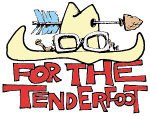|
Website visitor Alan M.
wrote to request that I scan this Dancer article from the February 1971 edition
of American Aircraft Modeler magazine. The Dancer is a beginner's level
control line trainer model for 1/2A power that is one of the many "For the Tenderfoot"
series. Construction is all simple sheet balsa. Even back in the early 1970s millions of Cox .049 engines had already been
produced, so they were readily available at a low price. The Dancer was designed
and built by AMA Junior level modeler Dennis Haimerl. A unique feature of the Dancer
is use of a leading edge slot to enhance lift and stall characteristics of the flat
airfoil of the wing. Such devices are used on STOL (short take-off and landing)
airplanes.
Dancer 1/2A Control Line Model
 Photos by the Author Photos by the Author
Dennis Haimerl is a Tenderfoot modeler, but he has designed his own control line
trainer. Full-size and ready-to-use plans are on pages 45 and 48.
Dancer is a simple model to construct because of its straight design. It does
require elevator hinges, but they are not difficult to install. Hinging methods
other than cloth (or other fibered materials) are up to the builder. However, cloth
is best.

What makes a good beginner's model? It must be rugged, easy to
make, interesting, fairly slow, and easy to fly.

Dancer beginner control line model.

The slot makes the flat wing act like a proper airfoil. Simple.

Large rudder and offset keep lines tight. Note slot gap above
wing.
Ready-to-use plans are on the back of the magazine's centerspread. For the wing
use a 1/8 x 3 x 24" piece of balsa. Mark its center and align with the center of
the plans. Wing tops are placed at the end of the balsa. Cut out the pieces.
After the wing has been assembled, pin it down on a flat board. Apply cement
liberally to the center of the wing and set the fuselage piece in place. Add the
1/4 x 1/4 x 3" fillets to each side and hold in place with pins. Using a small square,
make sure the fuselage is exactly vertical to the wing. Apply cement to the center
of the stabilizer and slide it into position in the fuselage slot. Again use the
square to be sure the trailing edge of the stabilizer is at a right angle to the
fuselage. Measure the distance from each stabilizer tip to the building board and
make sure they are the same.
Be sure the rudder is parallel to the fuselage. Set the trailing edge of the
rear piece offset 3/4 in. to the right of the fuselage.
Apply cement to the back of the plywood firewall and to the two 1/2" gussets,
then set into place. The firewall must be tight against the front of the fuselage.
Cement two of the 1/16" plywood pieces to the wing at the bellcrank location. Allow
the whole assembly to dry overnight.
Since the Dancer was built for flying, paint should be kept to a minimum. First
smooth all edges with fine sandpaper, then apply only a few coats of clear dope.
When the dope has dried, assemble the slot. It should be sanded as shown on the
plans for best performance. Cement the triangular slot supports to the wing and,
when they have dried, glue the slot in place. Cover these parts with clear dope.
The entire model may then be covered with one or two coats of color dope, if desired.
After the final coat has dried, the controls and engine are installed. Mount
the horn on the elevator and bend the pushrod to fit. Put the pushrod into the outer
hole of the bellcrank, which is then set on the 1/16" plywood pieces attached to
the wing. Drill a 3/32" hole through the bellcrank mount and attach the bell crank
with screws. If desired, make a landing gear of 1/16" music wire and mount it between
the engine and the firewall.
Flying is easy. Use a 6-3 propeller and 20- to 30-ft. flying lines. Launch downwind
to keep the lines tight. Have your helper toss the model level so that the controls
are not jerked.
Material List
1 Baby Bee 049
1 pc. 1/8 x 3 x 24" balsa wing
1 pc. 1/4 x 3 X 12" balsa fuselage
1 pc. 3/32 x 3 x 15" balsa tail
2 pcs. 1/4 x 1/4 X 3" balsa wing fillet
2 pcs. 1/2 x 1/22 x 1 3/4" balsa firewall gusset
2 pcs. 1/16 x 3/4 x 1" plywood
1 pc. 1/8 x 1 1/4 x 1 3/4" balsa firewall
1 pc. 1/8 x 1/2 x 12" balsa slot
1 1/2-A-size bellcrank and horn package
1 pc .055 x 12" music wire pushrod
1/16 x 9" music wire landing gear
1 pc. 2 x 3 1/2" silk cloth hinges
1 pc. 1/16 x 1/2 x 2" plywood
2 light 1-in. dia. wheels
4 #3 x 3/8 wood screws
small jar clear dope

Dancer Plans
Notice:
The AMA Plans Service offers a
full-size version of many of the plans show here at a very reasonable cost. They
will scale the plans any size for you. It is always best to buy printed plans because
my scanner versions often have distortions that can cause parts to fit poorly. Purchasing
plans also help to support the operation of the
Academy of Model Aeronautics - the #1
advocate for model aviation throughout the world. If the AMA no longer has this
plan on file, I will be glad to send you my higher resolution version.
Try my Scale Calculator for
Model Airplane Plans.
Posted February 23, 2024
(updated from original
post on 3/14/2013)
|



